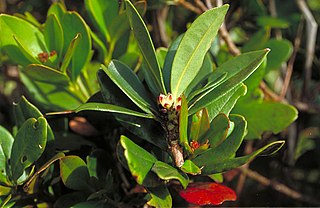
Acronychia littoralis, commonly known as the scented acronychia, is a species of small tree that is endemic to eastern coastal Australia. It has simple, glabrous, elliptic to egg-shaped leaves, small groups of yellow flowers and egg-shaped to more or less spherical creamy-yellow fruit.

Acronychia baeuerlenii, commonly known as Byron Bay acronychia, is a species of rainforest shrub or small tree endemic to eastern Australia. It has simple, glabrous leaves, small groups of flowers and fleshy oval fruit.

Boronia excelsa is a plant in the citrus family Rutaceae and is endemic to a small area in Far North Queensland. It is an erect shrub with woolly-hairy branches, simple, stalkless, more or less hairless leaves, and pink to white, four-petalled flowers.

Boronia parviflora, commonly known as the swamp boronia, small boronia, tiny boronia, or small-flowered boronia, is a plant in the citrus family Rutaceae and is endemic south-eastern Australia. It is a weak, low shrub with elliptic to egg-shaped leaves with finely toothed edges and up to three pink, white or green four-petalled flowers arranged at or near the ends of the stems.
Acronychia eungellensis, commonly known as Eungella aspen, is a species of small rainforest tree that is endemic to a restricted area in east-central Queensland. It has simple, elliptic leaves on cylindrical stems, flowers in small groups in leaf axils, and fleshy fruit that is elliptic to egg-shaped in outline.

Acronychia imperforata, commonly known as Logan apple, Fraser Island apple, or green tree, is a species of rainforest shrub or small tree that is endemic to north-eastern Australia. It has simple, elliptical to egg-shaped leaves, small groups of yellowish or creamy white flowers and fleshy spherical to oval fruit.

Acronychia parviflora is a species of shrub or small rainforest tree that is endemic to north-eastern Queensland. It has simple, egg-shaped to elliptical leaves, flowers arranged singly or in small groups in leaf axils and fleshy, more or less spherical fruit.

Acronychia vestita, commonly known as white aspen, lemon aspen, hairy aspen or fuzzy lemon aspen, is a species of rainforest tree that is endemic to Queensland. It has simple, elliptic to egg-shaped leaves with the narrower end towards the base, flowers arranged in relatively large groups, mostly in leaf axils and fleshy, pear-shaped to more or less spherical fruit.

Medicosma fareana, commonly known as white aspen, is a species of rainforest small tree in the family Rutaceae and is endemic to north Queensland. It has elliptical leaves and white or cream-coloured flowers borne singly or in small groups in leaf axils.
Medicosma forsteri is a species of small tree in the family Rutaceae and is endemic to a restricted area of Queensland. It has elliptical leaves and cream-coloured flowers borne singly or in small groups in leaf axils.

Medicosma glandulosa is a species of shrub or small tree in the family Rutaceae and is endemic to far north Queensland. It has elliptical to egg-shaped leaves and flowers that are white with red tips or cream-coloured, borne singly or in small groups in leaf axils.
Medicosma heterophylla is a species of small tree in the family Rutaceae and is endemic to a restricted area of far north Queensland. It has simple and trifoliate, elliptical leaves and leaflets, and cream-coloured to pink or reddish flowers borne singly or in small groups in leaf axils.
Medicosma mulgraveana is a species of small tree in the family Rutaceae and is endemic to a restricted area of far north Queensland. It has mostly trifoliate leaves with elliptical to egg-shaped leaflets and white flowers borne in small groups in leaf axils.
Medicosma obovata is a species of shrub or small tree in the family Rutaceae and is endemic to a restricted area of far north Queensland. It has simple egg-shaped leaves with the narrower end towards the base and white flowers borne singly or in small groups in leaf axils.

Medicosma sessiliflora is a species of shrub or small tree in the family Rutaceae and is endemic to far north Queensland. It has simple elliptical to egg-shaped leaves with the narrower end towards the base and cream-coloured flowers borne singly or in small groups in leaf axils.
Melicope affinis is a species of shrub or tree in the family Rutaceae and is endemic to Queensland. It has trifoliate leaves and small greenish white flowers borne in panicles in leaf axils.

Melicope broadbentiana, commonly known as false euodia, is a species of shrub or tree in the family Rutaceae and is endemic to Queensland. It has simple leaves, trifoliate leaves or both, and small white flowers borne in short panicles in leaf axils.

Melicope jonesii is a species of tree in the family Rutaceae and is endemic to north-east Queensland. It has trifoliate leaves and greenish or cream-coloured flowers borne in short panicles in leaf axils.
Melicope peninsularis is a species of small tree in the family Rutaceae and is endemic to tropical north Queensland. It has trifoliate leaves and white flowers borne in short panicles in leaf axils.
Philotheca freyciana, commonly known as the Freycinet waxflower, is a species of flowering plant in the family Rutaceae and is endemic to a small area of Tasmania. It is a small, erect shrub with intertwined, heart-shaped to egg-shaped leaves with the narrower end at the base, and white, five-petalled flowers arranged singly in leaf axils.












